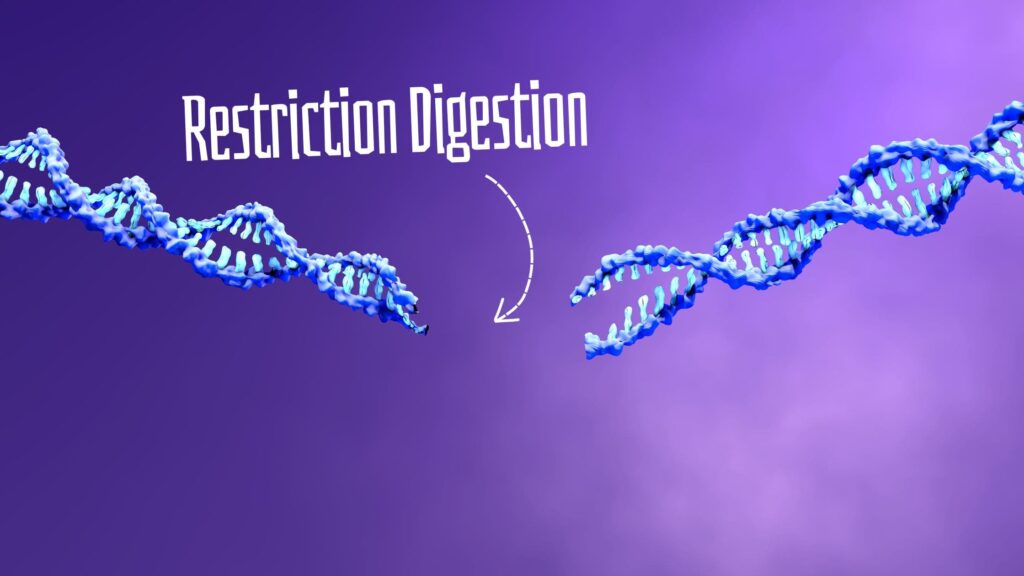“An agarose gel electrophoresis is used to run, study and analyze restriction digestion results. Here is a complete guide on restriction digestion gel results analysis for beginners and seasoned scientists.”
Restriction digestion is a process of cleaving a DNA. An endonuclease does this job using the recognition site present on the target DNA. In our previous article, I have explained the entire story of the present technique. Go and check out that article first.
Restriction digestion results are a bit tricky and different than PCR results. Therefore, some level of expertise is required to understand the results. But don’t worry, after reading this article, you can do it by yourself.
In this article, I will explain restriction gestion gel, the results and the analysis part with a hypothetical example and some real gel images.
Stay tuned.
Key Topics:
Restriction digestion gel:
A restriction digestion gel is a standard agarose gel and runs using the horizontal gel electrophoresis unit. Usually, the fragments produced by RE are smaller than the PCR products and thus, run on the 3% agarose gel instead of 2% PCR gel.
On the standard 2% PCR agarose gel, we can’t run smaller fragments efficiently. It may diffuse or fade. By running on 3% agarose gel, for at least 1 hour, we can get excellent results and separation in digestion experiments.
Note that restriction digestion PCR products, plasmids or library fragments can be run on only 2.5 to 3% agarose gel. The gel can be analyzed on a UV transilluminator or gel doc system.
Note that care must be taken and standard SOP must be followed while using the UV transilluminator.
Restriction digestion results:
Now to understand the results, let’s take an example. Consider that we performed an RFLP experiment and our PCR product is 300 bp. Now consider that we are digesting the PCR product with the EcoR1 REase.
Before moving ahead, if you want to learn more about REases you can read this article first: What are Restriction Enzymes? Top 10 Restriction Enzymed Used in Genetic Engineering.
Assume that the ECoR1 has a single recognition site on the 300 bp fragment and After digestion, we will get 70 and 230 bp fragments. Now in this case we will get two types of results,
- Two separate bands of 70 bp and 230 bp in case of digestion.
- An intact 300 bp fragment in case of no- digestion.
The hypothetical representation of the present scenario is given in the figure above. In a gel, we will get three types of results. Note that here, the REase will cut our wild-type allele and not the mutant-type allele, thus,
- Two separate DNA bands of 270 bp and 30 bp will be observed in the homozygous wild-type condition as both the alleles possess the recognition site.
- A single dominant DNA band of 300 bp will be observed in the homozygous mutant condition as both alleles lack the recognition site (possibly due to the mutation).
- Three different bands of 300 bp, 270 bp and 30 bp will be observed in the heterozygous condition as both mutant and wild-type alleles are present.
This is a simple understanding of a restriction digestion gel. It might be possible that some REase may cut the mutant allele and not the wild type and should contain more than a single recognition site.
It entirely depends on how you select the restriction endonuclease enzyme for your experiment. Now let’s analyze our hypothetical gel and then discuss a few results that I have.
Restriction digestion results analysis:
In our hypothetical gel Image, 6 different samples are loaded in the gel.
The first lane is the molecular marker or DNA ladder of 1000 bp. You can use a 2500 or 3000-bp DNA ladder. Again, that depends on the largest size of the fragment you have. For instance– if you have a 1000 or 1200 bp fragment for digestion, use a 2000 or 3000 bp DNA ladder.
The second lane as we said, is for homozygous wild type sample.
The third lane is for a heterozygous sample.
The fourth lane is for the homozygous mutant-type sample.
The fifth lane is for the control. Usually, we load the PCR product as an external control.
This is a gel plate of one experiment in which we have digested the DNA with NIaIII REase. Upon digestion of a 400 bp fragment, we got 225 and 175 bp fragments. The homozygous and heterozygous conditions are explained in the figure.
This one is a bit different image. The sample is digested with MspI REase. In the homozygous normal condition (lanes 2 and 7) 196 bp and 70 bp fragments appear. Sample 3 is a homozygous mutant sample that only contains intact 266 bp fragments.
The rest of the samples (4, 5, 6 and 8) are heterozygous and contain 266, 196 and 70 bp DNA fragments. However, the gel is not in good condition, and the 70 bp fragment doesn’t appear. An additional fragment of 56 bp is also observed here.
Tips for Restriction Digestion Gel Analysis:
- Always select a good restriction enzyme with minimum recognition sites.
- The target sequence should be at least 1000 bp long so that we can get decent banding patterns.
- Run a gel on 3% gel to get a good resolution and banding pattern.
Related article: 6 Optimization to Improve Genotyping.
Wrapping up:
Restriction digestion is an amazing molecular genetic technique for genotyping. Particularly, the RFLP (Restriction Digestion Length Polymorphism) is a popular technique in which we use digestion.
Keep in mind the result’s efficiency and clarity depend on how you choose the REase. If you have a report of restriction digestion, you certainly observe these things in the reports.
I hope this small content will help you in your genetic learning. Read more related articles on this topic and strengthen your molecular genetic knowledge.
